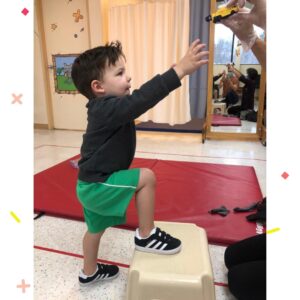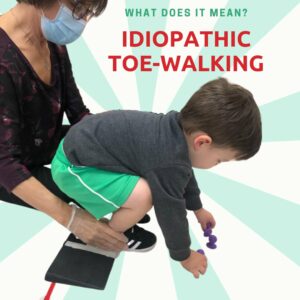Blog

Toe Walking
TOE WALKING is identified when a child walks on the balls of their feet and their heels do not contact the ground.

Though common in children who are learning to walk, most outgrow the habit and move to a normal heel-to-toe gait. In rare cases, if toe walking persists (after the age of two or three), it may be a sign of an underlying medical issue such as cerebral palsy, muscular dystrophy, or autism spectrum disorder. If associated with a medical diagnosis, the focus would be on the underlying condition. However, in most cases, there is no cause and is considered “idiopathic” toe walking.
For children who are growing and developing normally, toe walking on its own is unlikely to be cause for concern. There are some signs that may prompt consultation with a healthcare professional:
- walks on toes all of the time
- has stiff or sore muscles
- stumbles or walks awkwardly
- can’t bear weight on flat feet
- loses previously developed motor skills
- starts toe walking after having walked flat foot
If your child is a toe walker or has displayed any of the above-mentioned signs, and you would like a professional assessment, our team is here to help. We are very experienced in treating toe walking and will build a program based on gently stretching tight muscles and retraining legs and feet to walk in a heel-to-toe pattern.
Toe Walking: Part 2
So, your physiotherapist has let you know that your child’s toe-walking is “idiopathic”. But what does that mean?
Definition-wise, this means there is no known cause. But there can be many body systems involved in causing a child to go up on their toes.
You may notice that your child is able to go flat foot at times, but other times will continue to be on their toes. Why?
This may not always be related to tight and stiff ankles.
One system that is consistently involved in toe walking is the muscular system. A weak core can cause your body to seek stability. One way of doing that is making the body rigid, by straightening knees and going up on toes.
However, like trying to walk on stilts, we know this isn’t functional.
If you see your child having difficulties:
- balancing on one foot with foot flat on the ground
- standing/moving on unstable surfaces
- squatting/bending knees to pick up objects from the floor
- running, jumping, hopping or skipping with body control
Have a chat with your CYP physiotherapist to see if there are any exercises or strategies to help you and your child.
Toe Walking: Part 3
In our last post, we mentioned that “idiopathic” toe walking can be affected by many body systems. The muscular system being one and the sensory system is another.
But what is the sensory system?
The sensory system involves all of our senses: touch, smell, vision, body awareness, sound, taste and sense of balance.
Let’s talk touch. Feet have many nerve receptors, more than many other parts of our bodies. If these nerve receptors are extra sensitive, our body will want to “feel less”, and tell us to go up on our toes.
Other times we may see a child who has a hard time “regulating” their bodies. When they are excited, frustrated, surprised, anxious or in a busy/overwhelming setting this appears to create an “on the toes” response.
If you are seeing your child:
- go up on their toes more in bare feet
- go up on their toes more on cold, bumpy, slimy, etc. surfaces
- go up on their toes when feeling a strong emotion
- go up on their toes in a space that is crowded or noisy
Have a chat with your CYP physiotherapist to see if there are any exercises or strategies to help you and your child. They will let you know whether your child may benefit from seeing an occupational therapist to help identify sensory needs.
Toe Walking: Part 4, Vestibular and Visual Systems
The vestibular system is our inner ear system. Its main purpose is to detect movement of our head on our body, our body on our head and both in relation to movement around us.
Yes, the visual system is what we see. It is also our brain’s ability to take in what we see AND how our eyes move both consciously and subconsciously.
But what does this have to do with toe walking?
The vestibular system tells our muscles how to work against gravity, helping us maintain our balance and a strong upright posture. If our vestibular system is not functioning to the best of its ability, it can cause issues with core strength and balance.
The visual system has a close relationship with the vestibular system. An example? When our head moves, our eyes move in the opposite direction when we are focused on a target.
We mentioned the visual system also involves the brain’s ability to process what we see. If our brain is feeling overwhelmed with information visually coming in, it will want us to “see” less. By going up on our toes, we can “lock” our feet in an attempt to gain stability. As a common theme, this creates “stability”.
If your child goes up on their toes and:
- has reduced awareness of their surroundings
- trips and falls easily
- has difficulties staying balanced on a moving surface
- complains about dizziness or motion sickness
Have a chat with your CYP physiotherapist to see if there are any exercises or strategies to help you and your child. This may also include collaboration with other local visual and vestibular health professionals.


